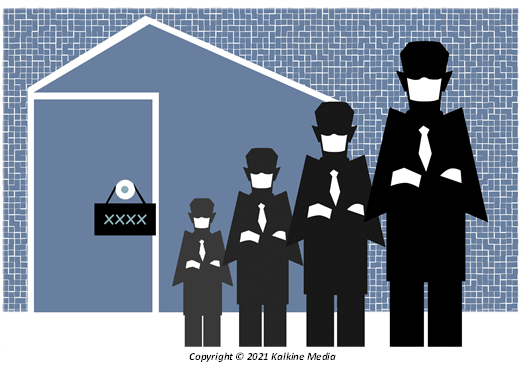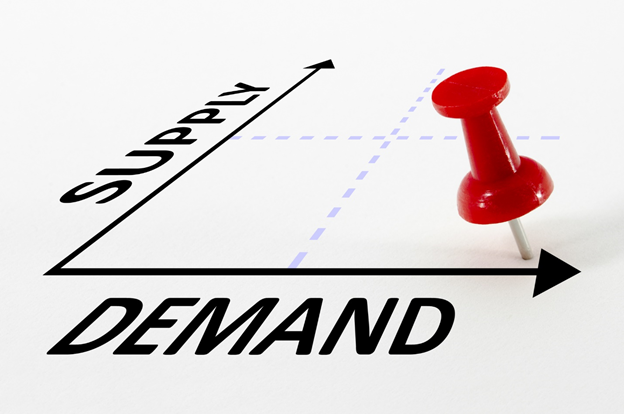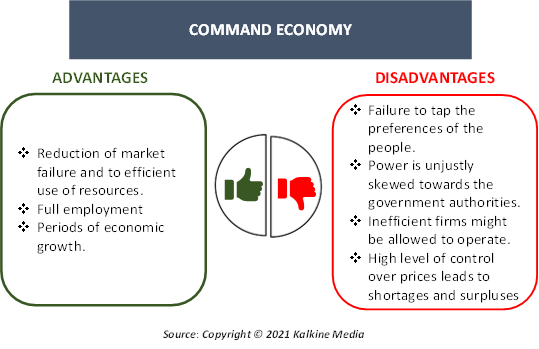What is a command economy?
It refers to a system where a central authority has a higher level of control over the production in an economy. Decision on the kind of goods to be produced, quantity to be produced and the prices of the goods to be are decided centrally. This contrasts with a free market wherein the market forces determine these aspects. In a free market, private enterprises have higher control over what they want to produce and how much they want to produce.

The government may also have control over incomes and savings in a command economy. The level of competition is mostly low because most businesses are government owned. Due to high levels of government involvement and control, a command economy is also termed as a planned economy.
Summary
- Command economy is system wherein the central authority takes a call on the production, rate of production and the price of end product.
- Command economies are linked to the political system of communism.
- A command economy is the converse of a free market system wherein market forces decide the production level and prices.
- Governments may also get to decide on the incomes and level of public investments in command economies, which is why they are also called planned economies.
Frequently Asked Questions (FAQs)
How does a command economy work?
Command economies run based on what is known as a central economic plan. This plan sets out goals for the economy as well as for the society, dictating the tasks for every sector and region of the country. This is accompanied by short-term goals that determine the actionable objectives.
Now the government must allocate resources given this central plan. The inherent capital, land and natural resources combines with people’s skills are to be used in the most efficient manner. The goal here is lead to full employment, as the government gets to choose what level of employment is to be maintained in the economy.

Employment, Image Source: © Sophiesourit | Megapixl.com
The government may also put quotas and price controls to gain power over the level of production. The production levels are determined keeping in mind the priorities of the country. These may include preparing for a war, as was the case in olden times or even aiming for increased economic growth.
Most of the businesses are government owned which eliminates the needs for businesses to have competitive prices or offer higher quality products. Additionally, no changes to the plan can be allowed even if free market forces do not go in accord with it.
In a command economy, it is possible some private enterprises exist. However, these private companies would be closely monitored by the government and must follow all central directives.
What are differences between a command economy and a free market economy?
Free market economies allow more freedom to businesses to decide how they want to run. Be it pricing or a decision on the level of production, free market allows firms to be more in control. However, there are few characteristics which sets aside a command economy from a free market economy.
In a free market, workers are hired based on the movement of supply and demand forces. This means that if a particular industry sees a boom in demand, its production increases and thus, there is increased demand for labor in that industry. However, in a command economy, labor force is assigned to each sector, irrespective of what the market forces suggest, in order to ensure that employment is taken care of.

Supply And Demand Analysis Concept, Image Source: © Pricelessphotos | Megapixl.com
Additionally, in a free market economy, there is greater incentive for firms to earn a profit. In a command economy businesses are given very little support.
What are the benefits of a command economy?
Those in favor of command economy make the argument that these economies lead to the reduction of market failure and to efficient use of resources. Additionally, the structure of a command economy is made in a way that employs all the people. Thus, there is higher level of employment than in the case of free market.
Command economies are also linked to periods of economic growth. Historically, countries that followed a command economy have shown periods of rapid growth, despite the ultimate failure of the system.
What are the disadvantages of a command economy?
- Command economies may produce goods that are not even required or demanded in the economy. Simply put, this is a wastage of resources as inputs are being used to produce goods without proper knowledge of the market. This has been seen in the case of countries that have adopted a command economy wherein goods produced remained underutilized due to improper knowledge of the market.
- The flip side of the coin suggests that there may be unmet demand for certain goods that are not being produced enough. This means that consumer preferences are not being considered.
- Power is unjustly skewed towards the government authorities, leaving little to no room for industries to decide how they want to operate. This level of control can seep into areas other than economy and production.
- Inefficient firms might be allowed to operate, leading to a failing market. Since everything is planned, firms that are not efficient in production would be allowed to operate, taking a toll on resources of the nation.
- The high level of control over prices leads to shortages and surpluses in the economy.

Many countries that have adopted command economies in the past have failed, leading them to adopt free market economy. China and Soviet Union, which were both command economies, slowly deregulated many industries and privatized businesses leading to a mixed economy structure. However, the political structure of these countries remains unaffected by this transition.
North Korea largely remains a command economy still and so does Cuba. North Korea has prioritized a more sever form of command economy and has received major criticism from other countries.
 Please wait processing your request...
Please wait processing your request...